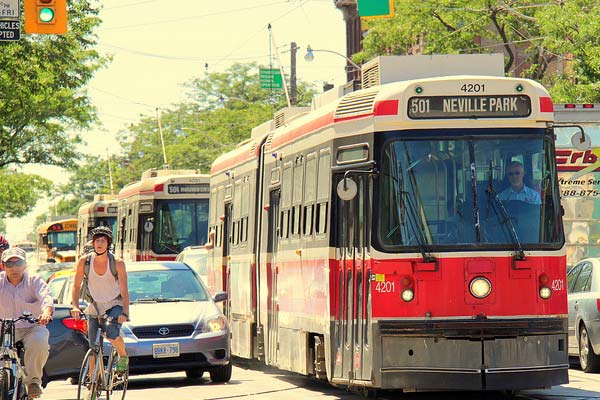
Taking a public look at Toronto transit
Published: September 21, 2015
Toronto's four universities are working together to examine how public transit can be improved, with a primary focus on helping students commuting to school.
The collaboration includes the launch on Monday of a new student travel behaviour survey at Toronto City Hall.
The event is an interactive symposium with students, researchers and public transit officials. Speakers include University of Toronto President Meric Gertler and OCAD University President Sara Diamond, York University President Mamdouh Shoukri and Ryerson University Provost and Vice-President Mohamed Lachemi.
“My colleagues and I had no trouble identifying this as the first initiative in our new collaboration on shared priorities,” Gertler told U of T News. “Transportation infrastructure is a huge and pressing issue in the city-region we’re part of, and no group is affected more than students. Unreasonably long commutes make it much more difficult for our students to focus on their education and to make the most of it.
“By bringing students, academic experts, and city officials together in a focused conversation, we’re hoping to spur action to address the problem, and to support our students in making their voices heard,” Gertler said. “For me, as president of U of T, it’s one way of advancing two of the university’s top priorities – our contribution to the city-region around us, and our undergraduates’ educational experience.”
A new group has been created by the four universities, called StudentMoveTO, which aims to “promote and improve mobility for students within the GTHA through research, teaching and knowledge mobilization.” In an invitation to students, it says the symposium will discuss “the difficult and sometimes bewildering obstacles students confront with travelling in the GTHA (Greater Toronto-Hamilton Area).”
In planning the initiative Gertler wrote to his colleagues that the need for new investment in transportation infrastructure in the region is now widely accepted.
In the most densely built-up neighbourhoods, demand for public transit outstrips supply by a considerable margin, the president wrote. With further development anticipated as central areas continue to intensify, this challenge will only get worse in the absence of significant investments to expand capacity and enhance service.
Studies have shown that low-income neighbourhoods are likely to be least well served by the existing transportation system, inhibiting access to employment and education opportunities.
The impact on university students is especially acute, Gertler wrote, with all four universities having high proportions of students who live off-campus and commute daily to and from their studies.
Scholars from the four institutions have been working for a year to create the transportation survey.
Matti Siemiatycki, an associate professor of geography and planning at U of T, and one of the organizers of the symposium, told U of T News that “through StudentMoveTO, the universities have come together to conduct one of the largest surveys of student travel ever by reaching out to students at all four institutions.
“We know that traveling in [the region] can be a challenge for students, often characterized by long distances and high costs; this can impact on student engagement with their studies and university life. The StudentMoveTO initiative makes it possible to understand what parts of the transportation system are working in the region, and which are not.”
The results, Siemiatycki said, will be made public “so that they can be used by all stakeholders to learn how students use the transportation system in the region and inform policy decisions.”



